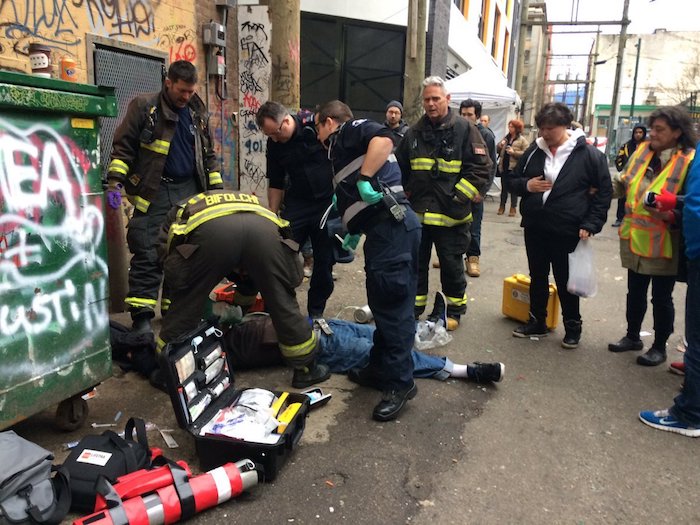Addictions
Should fentanyl dealers face manslaughter charges for fatal overdoses?

Tyler Ginn prior to his death from a fentanyl overdose in 2021. [Photo credit: Gayle Fowlie]
By Alexandra Keeler
Police are charging more drug dealers with manslaughter in fentanyl overdose deaths. But the shift is not satisfying everyone
Four years ago, Tyler Ginn died of a fentanyl overdose at the age of 18. Tyler’s father found his son unresponsive in the bedroom of their Brooklin, Ont., home.
For Tyler’s mother, Gayle Fowlie, the pain of his loss remains raw.
“He was my kid that rode his bike to the store to buy me a chocolate bar on my birthday, you know?” she told Canadian Affairs in an interview.
Police charged Jacob Norn, the drug dealer who sold Tyler his final, fatal dose, with manslaughter. More than three years after Tyler’s death, Norn was convicted and sentenced to six years in prison.
“I don’t think you can grasp how difficult going through a trial is,” Fowlie said. “On TV, it’s a less than an hour process. But the pain of it, and going over every detail and then going over every detail again … it provides details you wish you didn’t know.”
But Fowlie is glad Norn was convicted. If anything, she would have liked him to serve a longer sentence. Lawyers have told her Norn is likely to serve only two to four years of his sentence in prison.
“My son’s never coming back [and] his whole family has a life sentence of missing him the rest of our lives,” she said. “So do I think four years is fair? No.”
Norn’s case reflects a growing trend of drug dealers being charged with manslaughter when their drug sales lead to fatal overdoses.
But this shift has not satisfied everyone. Some would like to see drug dealers face harsher or different penalties.
“If we say that it was 50 per cent Tyler’s fault for buying it and 50 per cent Jacob’s fault for selling it … then I think he should have a half-a-life sentence,” said Fowlie.
Others say the legal system’s focus on prosecuting low-level drug dealers misses the broader issues at play.
“[Police] decided, in the Jacob Norn case, they were going to go one stage back,” said Peter Thorning, who was Norn’s defence lawyer.
“What about the person who gave Jacob that substance? What about the person who supplied the substance to [that person]? There was no investigation into where it came from and who was ultimately responsible for the death of that young man.”
Manslaughter charge
At least 50,000 Canadians have died from drug overdoses since 2016. Last year, an average of 21 individuals died each day, with fentanyl accounting for nearly 80 per cent of those deaths.
Fentanyl, a synthetic opioid, is up to 50 times stronger than heroin and 100 times stronger than morphine. A dose as small as a few grains of salt can be lethal.
Given its potency, police and prosecutors have increasingly turned to manslaughter charges when a dealer’s product results in a fatal overdose.
A recent study in the Canadian Journal of Law and Society found that the number of manslaughter charges laid for drug-related deaths in Canada surged from three cases in 2016 to 135 in 2021.
Individuals can be convicted of manslaughter for committing unlawful, reckless or negligent acts that result in death but where there was no intention to kill. Sentences can range from probation (in rare cases) to life.
Murder charges, by contrast, require an intent to kill or cause fatal harm. Drug dealers typically face manslaughter charges in overdose cases, as their intent is to distribute drugs, not to kill those who purchase them.
Joanne Bortoluss, a spokesperson for the Durham Regional Police, which charged Norn, said that each of their investigations follows the same fundamental process.
“Investigators consider the strength of the evidence, the dealer’s level of involvement, and applicable laws when determining whether to pursue charges like manslaughter,” she said.
The Canadian Journal of Law and Society study also found that prosecutions often target low-level dealers, many of whom are drug users themselves and have personal connections to the deceased.
Norn’s case fits this pattern. He struggled with substance abuse, including addiction to fentanyl, Xanax and Percocet. Tyler and Norn were friends, the judge said in the court ruling, although Fowlie disputes this claim.
“[Those words] are repulsive to me,” she said.
The Crown argued Norn demonstrated “a high degree of moral blameworthiness” by warning Ginn of the fentanyl’s potency while still selling it to him. In a call to Ginn, he warned him “not to do a lot of the stuff” because he “didn’t want to be responsible for anything that happened.”
Fowlie’s outrage over Norn’s lenient sentencing is compounded by the fact that Norn was found trafficking fentanyl again after her son’s death.
“So we’ve killed somebody, and we’re still … trafficking? We’re not worried who else we kill?” Fowlie said.

Trafficking
Some legal sources noted that manslaughter charges do not necessarily lead to harsh sentences or deterrence.
“If you look at how diverse and … lenient some sentences are for manslaughter, I don’t think it really pushes things in the direction that [victims’ families] want,” said Kevin Westell, a Vancouver-based trial lawyer and former chair of the Canadian Bar Association.
Westell noted that the term “manslaughter” is misleading. “Manslaughter is a brutal-sounding title, but it encapsulates a very broad span of criminal offences,” he said.
In Westell’s view, consistently charging dealers with drug trafficking could be more effective for deterring the practice.
“What really matters is how long the sentence is, and you’re better off saying, ‘We know fentanyl is dangerous, so we’re setting the sentence quite high,’ rather than making it harder to prove with a manslaughter charge,” he said.
Trafficking is a distinct charge from manslaughter that involves the distribution, sale or delivery of illicit drugs. The sentencing range for fentanyl trafficking is eight to 15 years, Kwame Bonsu, a media relations representative for the Department of Justice, told Canadian Affairs.
“Courts must impose sentences that are proportionate to the gravity of the offence and the degree of responsibility of the offender,” Bonsu said, referencing a 2021 Supreme Court of Canada decision. Bonsu noted that aggravating factors such as lack of remorse or trafficking large quantities can lead to harsher sentences.
‘Head of the snake’
Some legal experts noted the justice system often fails to target those higher up in the drug supply chain.
“We don’t know how many hands that drug goes through,” said Thorning, the defence lawyer.
“Are the police going to prosecute every single person who provides fentanyl to another person? Jacob [Norn] was himself an addict trafficker — what about the person who supplied the substance to him?”
Thorning also questioned whether government agencies bear some responsibility. “Is some government agency’s failure to investigate how that drug came into the country partly responsible for the young man’s death?”
Westell, who has served as both a Crown prosecutor and criminal defence lawyer, acknowledged the difficulty of targeting higher-level traffickers.
“Cutting off the head of the snake does not align very well with the limitations of the international borders,” he said.
“Yes, there are transnational justice measures, but a lot gets lost, and as soon as you cross an international border of any kind, it becomes incredibly difficult to follow the chain in a linear way.”
Bortoluss, of the Durham police, said even prosecuting what appear to be obvious fentanyl-related deaths — such as Tyler Ginn’s — can be challenging. Witnesses can be reluctant to cooperate, fearing legal consequences. It can also be difficult to identify the source of drugs, as “transactions often involve multiple intermediaries and anonymous online sales.”
Another challenge in deterring fentanyl trafficking is the strong financial incentives of the trade.
“Even if [Norn] serves two to four years for killing somebody, but he could make a hundred thousand off of selling drugs, is it worth it?” Fowlie said.
Thorning agreed that the profit incentive can be incredibly powerful, outweighing the risk of a potential sentence.
“The more risky you make the behaviour, the greater the profit for a person who’s willing to break our laws, and the profit is the thing that generates the conduct,” he said.
A blunt instrument
Legal experts also noted the criminal justice system alone cannot solve the fentanyl crisis.
“Most people who have [lost] a loved one [to drug overdose] want to see a direct consequence to the person that’s responsible,” said Westell. “But I think they would also like to see something on a more macro level that helps eliminate the problem more holistically, and that can’t be [achieved through] crime and punishment alone.”
Thorning agrees.
“These are mental health .. [and] medical issues,” he said. “Criminal law is a blunt instrument [that is] not going to deal with these things effectively.”
Even Fowlie sees the problem as bigger than sentencing. Her son struggled with the stigma associated with therapy and medication, which made it difficult for him to seek help.
“We need to normalize seeing a therapist, like we normalize getting your eyes checked every year,” she said.
“Pot isn’t the gateway drug, trauma is a gateway drug.”
This article was produced through the Breaking Needles Fellowship Program, which provided a grant to Canadian Affairs, a digital media outlet, to fund journalism exploring addiction and crime in Canada. Articles produced through the Fellowship are co-published by Break The Needle and Canadian Affairs.
Subscribe to Break The Needle – or donate to our investigative journalism fund.
Addictions
BC premier admits decriminalizing drugs was ‘not the right policy’

From LifeSiteNews
Premier David Eby acknowledged that British Columbia’s liberal policy on hard drugs ‘became was a permissive structure that … resulted in really unhappy consequences.’
The Premier of Canada’s most drug-permissive province admitted that allowing the decriminalization of hard drugs in British Columbia via a federal pilot program was a mistake.
Speaking at a luncheon organized by the Urban Development Institute last week in Vancouver, British Columbia, Premier David Eby said, “I was wrong … it was not the right policy.”
Eby said that allowing hard drug users not to be fined for possession was “not the right policy.
“What it became was a permissive structure that … resulted in really unhappy consequences,” he noted, as captured by Western Standard’s Jarryd Jäger.
LifeSiteNews reported that the British Columbia government decided to stop a so-called “safe supply” free drug program in light of a report revealing many of the hard drugs distributed via pharmacies were resold on the black market.
Last year, the Liberal government was forced to end a three-year drug decriminalizing experiment, the brainchild of former Prime Minister Justin Trudeau’s government, in British Columbia that allowed people to have small amounts of cocaine and other hard drugs. However, public complaints about social disorder went through the roof during the experiment.
This is not the first time that Eby has admitted he was wrong.
Trudeau’s loose drug initiatives were deemed such a disaster in British Columbia that Eby’s government asked Trudeau to re-criminalize narcotic use in public spaces, a request that was granted.
Records show that the Liberal government has spent approximately $820 million from 2017 to 2022 on its Canadian Drugs and Substances Strategy. However, even Canada’s own Department of Health in a 2023 report admitted that the Liberals’ drug program only had “minimal” results.
Official figures show that overdoses went up during the decriminalization trial, with 3,313 deaths over 15 months, compared with 2,843 in the same time frame before drugs were temporarily legalized.
Addictions
Canada must make public order a priority again

A Toronto park
Public disorder has cities crying out for help. The solution cannot simply be to expand our public institutions’ crisis services
[This editorial was originally published by Canadian Affairs and has been republished with permission]
This week, Canada’s largest public transit system, the Toronto Transit Commission, announced it would be stationing crisis worker teams directly on subway platforms to improve public safety.
Last week, Canada’s largest library, the Toronto Public Library, announced it would be increasing the number of branches that offer crisis and social support services. This builds on a 2023 pilot project between the library and Toronto’s Gerstein Crisis Centre to service people experiencing mental health, substance abuse and other issues.
The move “only made sense,” Amanda French, the manager of social development at Toronto Public Library, told CBC.
Does it, though?
Over the past decade, public institutions — our libraries, parks, transit systems, hospitals and city centres — have steadily increased the resources they devote to servicing the homeless, mentally ill and drug addicted. In many cases, this has come at the expense of serving the groups these spaces were intended to serve.
For some communities, it is all becoming too much.
Recently, some cities have taken the extraordinary step of calling states of emergency over the public disorder in their communities. This September, both Barrie, Ont. and Smithers, B.C. did so, citing the public disorder caused by open drug use, encampments, theft and violence.
In June, Williams Lake, B.C., did the same. It was planning to “bring in an 11 p.m. curfew and was exploring involuntary detention when the province directed an expert task force to enter the city,” The Globe and Mail reported last week.
These cries for help — which Canadian Affairs has also reported on in Toronto, Ottawa and Nanaimo — must be taken seriously. The solution cannot simply be more of the same — to further expand public institutions’ crisis services while neglecting their core purposes and clientele.
Canada must make public order a priority again.
Without public order, Canadians will increasingly cease to patronize the public institutions that make communities welcoming and vibrant. Businesses will increasingly close up shop in city centres. This will accelerate community decline, creating a vicious downward spiral.
We do not pretend to have the answers for how best to restore public order while also addressing the very real needs of individuals struggling with homelessness, mental illness and addiction.
But we can offer a few observations.
First, Canadians must be willing to critically examine our policies.
Harm-reduction policies — which correlate with the rise of public disorder — should be at the top of the list.
The aim of these policies is to reduce the harms associated with drug use, such as overdose or infection. They were intended to be introduced alongside investments in other social supports, such as recovery.
But unlike Portugal, which prioritized treatment alongside harm reduction, Canada failed to make these investments. For this and other reasons, many experts now say our harm-reduction policies are not working.
“Many of my addiction medicine colleagues have stopped prescribing ‘safe supply’ hydromorphone to their patients because of the high rates of diversion … and lack of efficacy in stabilizing the substance use disorder (sometimes worsening it),” Dr. Launette Rieb, a clinical associate professor at the University of British Columbia and addiction medicine specialist recently told Canadian Affairs.
Yet, despite such damning claims, some Canadians remain closed to the possibility that these policies may need to change. Worse, some foster a climate that penalizes dissent.
“Many doctors who initially supported ‘safe supply’ no longer provide it but do not wish to talk about it publicly for fear of reprisals,” Rieb said.
Second, Canadians must look abroad — well beyond the United States — for policy alternatives.
As The Globe and Mail reported in August, Canada and the U.S. have been far harder hit by the drug crisis than European countries.
The article points to a host of potential factors, spanning everything from doctors’ prescribing practices to drug trade flows to drug laws and enforcement.
For example, unlike Canada, most of Europe has not legalized cannabis, the article says. European countries also enforce their drug laws more rigorously.
“According to the UN, Europe arrests, prosecutes and convicts people for drug-related offences at a much higher rate than that of the Americas,” it says.
Addiction treatment rates also vary.
“According to the latest data from the UN, 28 per cent of people with drug use disorders in Europe received treatment. In contrast, only 9 per cent of those with drug use disorders in the Americas received treatment.”
And then there is harm reduction. No other country went “whole hog” on harm reduction the way Canada did, one professor told The Globe.
If we want public order, we should look to the countries that are orderly and identify what makes them different — in a good way.
There is no shame in copying good policies. There should be shame in sticking with failed ones due to ideology.
Our content is always free – but if you want to help us commission more high-quality journalism,
consider getting a voluntary paid subscription.
-

 Red Deer1 hour ago
Red Deer1 hour agoThe City of Red Deer’s Financial Troubles: Here Are The Candidates I Am Voting For And Why.
-

 Alberta2 days ago
Alberta2 days agoClick here to help choose Alberta’s new licence plate design
-

 International2 days ago
International2 days agoDaughter convinces healthy father to die in double assisted suicide with mother
-

 International2 days ago
International2 days agoHamas will disarm or die
-

 illegal immigration2 days ago
illegal immigration2 days agoLos Angeles declares a state of emergency over ICE deportations
-

 International2 days ago
International2 days agoUS Warns Hamas To Halt Executions
-

 Indigenous2 days ago
Indigenous2 days agoConstitutional lawyer calls for ‘false’ claims to end in Canadian residential schools burials
-

 Business2 days ago
Business2 days ago‘Taxation Without Representation’: Trump Admin Battles UN Over Global Carbon Tax






